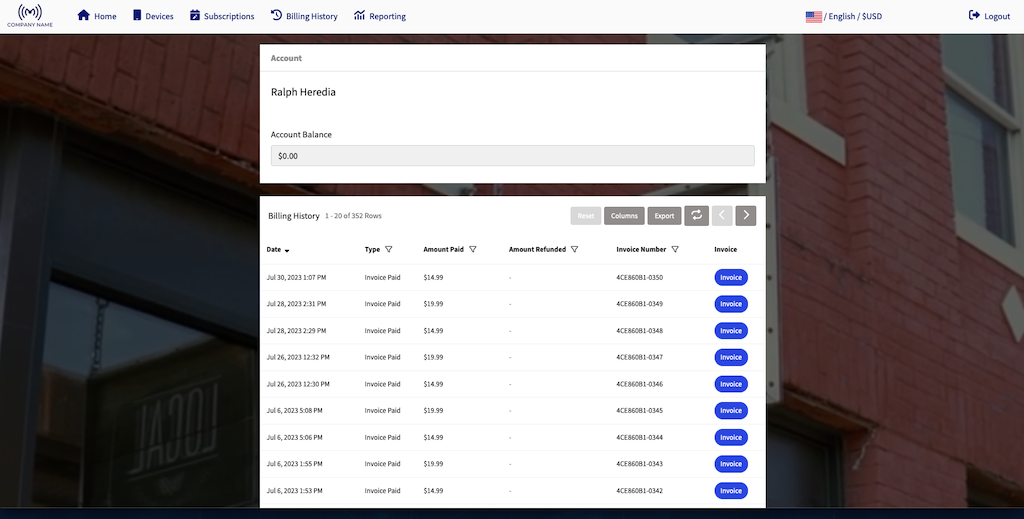Subscription Billing for OEMs:
Monetizing Your IoT Products Beyond the One-Time Sale
by Jim Greco
- Chapter I: Introduction
- Chapter II: Subscription billing in IoT
- Chapter III: The value of subscription billing for OEMs & the end-user
- Chapter IV: Subscription billing models & effective pricing strategies for IoT
- Chapter V: OEMs successfully using subscription billing models
- Chapter VI How to implement a subscription model for your business
- Chapter VII Overcoming the challenges of IoT subscription billing
- Chapter VIII Leveraging a subscription billing platform to earn recurring revenue
Introduction
The rise of the Internet of Things (IoT) alongside the booming “subscription economy” presents OEMs with an opportunity to maximize revenue beyond the device sale through the connectivity they require and the data they generate. The rapidly expanding subscription economy provides the perfect catalyst for the growth of IoT.
A 2019 Gartner Research report predicted that “by 2023, 75% of organizations selling direct to consumers will offer subscription services.” Gartner also stated in the same report that “billions of connected devices” would expand commerce, acting on behalf of customers to reduce the effort of making a purchase. But these predictions overlooked an important connection–subscription billing would make the deployments of billions of connected devices scaleable.
The subscription economy is projected to grow from $650 billion to $1.5 trillion by 2025. While subscription billing isn’t new, the proliferation of affordable and accessible smart devices has accelerated its widespread adoption. Smart devices have changed the consumer’s perception of convenience, as everything is now available at our fingertips. Subscription billing offers the predictability and convenience of monthly recurring charges that consumers expect and investors appreciate.
What does the growth of subscriptions mean for IoT?
As an OEM of IoT devices, this shift from a goods-driven to a subscription service-driven economy provides you the perfect opportunity to monetize and scale your solution. IoT devices must be monetized beyond the initial hardware sale to cover ongoing connectivity and maintenance costs. Fortunately, the value of IoT for the consumer lies in the data rather than the device, which makes IoT and the recurring charges of subscription billing a great match.
A McKinsey Global Survey indicates that the highest-performing and fastest-growing companies are the ones finding innovative ways to add value to customers through data. IoT devices offer ample data, but this data necessitates connectivity, SIM activation, and cloud access. All of these components can generate recurring revenue when managed through a dedicated billing platform. Meeting the increasing demand for connected devices requires a platform capable of handling massive and widespread activations and transactions without error. From the customer's viewpoint, the payment and device management portal should offer a user-friendly and convenient experience.
With the Zipit Wireless subscription billing platform, you can manage connectivity, SIM activation, and data in one place and provide your customers with seamless data plan management through a customer billing portal. With over a decade of experience in IoT monetization, we’ve helped numerous OEMs scale their IoT solutions. We’re certain that a subscription billing model can unlock new revenue streams and drive business growth for IoT providers.
The following chapters provide practical tips on transitioning from traditional billing to a subscription model and demonstrate the value of IoT through the experiences of OEMs who have monetized their products with Zipit's subscription billing.
Subscription Billing in IoT
What is subscription billing?
Subscription billing charges customers recurring fees at regular intervals, such as monthly or annually, for continued access to a product or service. In IoT subscriptions, customers choose a plan and pay recurring charges for ongoing access to the connectivity, data, cloud services, software updates, device analytics, support, and other services tied to their IoT devices.
In the IoT landscape, subscription billing controls the SIMs that connect devices to the network and allow them to transfer data. IoT SIMs ensure seamless connectivity throughout the subscription period. When customers subscribe to an IoT service or solution, the subscription fee includes not only the device itself but also the ongoing connectivity provided by the SIM card.
For example, when a subscription starts on Zipit’s billing platform, connectivity activates, and the platform begins to monitor the subscriber’s data usage. Notifications are sent to the subscriber if they near their data threshold, and they’ll have the chance to “top up.” If the subscriber’s data goes over a certain amount, the SIM can be deactivated. You can easily adapt and manage connectivity and data plans based on your customer needs, usage patterns, and subscription plans with remote management, over-the-air updates, and easy activations or deactivations.
Subscription billing in IoT is beneficial for you and your customers. As the OEM, subscriptions
- Provide you with recurring revenue streams,
- Improve customer retention,
- Offset ongoing costs of connectivity and maintenance,
- And gives insights from customer data to drive product enhancements and tailor services.
Your customers benefit from
- The convenience of predictable recurring payments,
- Access to the latest features and updates,
- Ongoing support,
- And the ability to scale or adjust their usage as needed.
Subscription billing vs. traditional billing
Unlike recurring charges with subscription billing, traditional billing follows a one-time purchase model, where customers make a single payment to acquire a product. The customer not only owns the product but also the continual use of its services. Once a customer completes the purchase, the revenue is realized, and there is no guaranteed future revenue from that customer without the purchase of an additional product.
Revenue forecasting for traditional billing is less predictable because it’s more heavily influenced by fluctuations in sales volume and customer demand, which vary over time. With subscription billing, you project future revenue based on the number of active subscriptions and the recurring nature of payments. The subscription revenue flow from each customer is long-term, cyclical, and steady.
Traditional billing can also reduce relationships with customers to infrequent interactions which can result in missed opportunities to improve customer experience. Once a product or service is sold and the transaction is complete, you lack the opportunity to provide additional value that can further improve brand sentiment and give you an edge against the competition. Subscription billing, on the other hand, provides ongoing relationships with customers as you deliver value and support throughout the subscription period. You can better understand your customers’ needs over time and meet them accordingly. For this reason, subscription billing often leads to higher customer retention rates.
Why is subscription billing better for IoT?
- Subscription billing is preferred for IoT products because of ongoing connectivity, cloud storage, and device maintenance costs. Consistent revenue from subscriptions offsets these costs.
- The variable data usage patterns among customers and the value that application data provide them also make subscription billing ideal for IoT.
- Data consumption varies among different customers, and subscription billing offers data tiers or usage-based pricing structures to reflect these variations, so customers only pay for the data they actually use.
- In addition to the device, your customers also need access to application data, which can be monetized as a subscription service.
- By adopting a subscription billing model, you can capture valuable insights into customer behavior, usage patterns, and preferences, which you can then use to enhance your product, personalize offerings, and identify upsell opportunities.
The limitations of a traditional billing system for IoT
Monetizing IoT involves managing complex pricing structures, handling large volumes of data, integrating with multiple systems, and support for scalability. The following characteristics of traditional billing systems make them insufficient in meeting the demands of IoT.
Prone to error
Traditional billing systems often rely on manual processes for invoicing. These manual tasks are susceptible to human error and increase the likelihood of delays, misplaced invoices, and other administrative errors that can negatively impact billing accuracy. Managing and applying different pricing for discounts, promotions, or payment tiers can lead to inconsistencies and overcharging or undercharging customers.
Lacking scalability
Traditional billing systems lack the scalability needed for large-scale IoT deployments. As device numbers increase, manual billing processes become cumbersome and require additional staffing. Traditional systems are also ill-equipped to handle the high volume of usage data generated by IoT devices. Real-time processing is crucial for accurate and timely billing, but the simplicity of traditional billing processes would delay invoices and usage reports. This limitation can hurt customer satisfaction and hinder the ability to offer dynamic pricing and adjust plans based on usage patterns.
Inflexible
IoT deployments involve devices and services with varying levels of usage. Traditional billing systems lack the flexibility and sophistication to accurately measure and attribute usage at the device or service level. Traditional billing systems aren’t flexible enough to support dynamic pricing, tiered plans, or personalized offerings that cater to diverse customer needs.
Limited insights
Traditional billing methods typically limit visibility into subscriber behavior and usage patterns. Without detailed insights into how customers interact with IoT devices or services, it’s challenging to understand their preferences or needs. Additionally, IoT ecosystems comprise multiple data sources, and traditional billing systems may face challenges in integrating and consolidating data from these diverse sources.
Ensuring data integrity and accuracy becomes increasingly challenging as the complexity of the IoT ecosystem grows. IoT deployments call for more specialized and advanced billing solutions. Subscription billing platforms specifically designed for IoT offer features, automation, and scalability needed to accurately bill for usage and address the challenges presented by IoT deployments.
Benefits of a subscription billing platform
1. Regular recurring revenue
Monetize your IoT products beyond the initial hardware sale and cover ongoing connectivity and maintenance costs with consistent and predictable revenue streams.
2. Better customer experience
Offer convenient and seamless payment processes for customers where they can easily set up automatic payments, manage their subscriptions, and receive timely invoices.
3. Stronger relationships with customers
Foster ongoing relationships with customers through regular billing cycles and access to services with opportunities for repeat purchases and upselling.
4. Greater efficiency
Eliminating the need for manual calculations, invoice generation, and payment tracking to save time, reduce errors, and increase operational efficiency.
5. Lower customer acquisition and retention expenses
Reduce customer acquisition costs with regular billing cycles. Track usage patterns and engagement to proactively address customer concerns, identify retention strategies, and reduce churn rates, ultimately lowering customer retention expenses.
6. Access to more data for strategic decision-making
Make informed decisions, refine offerings, personalize services, and identify new opportunities for growth by tracking usage data and monthly recurring revenue (MRR).
A subscription billing platform designed specifically for IoT
Zipit Wireless's subscription billing platform streamlines pricing calculations, invoicing, and data usage tracking while offering real-time reporting for accurate and consistent billing. But it also goes above and beyond a typical subscription platform to meet the specific challenges you face with an IoT product.
A concerned OEM approached Zipit about the lack of insights provided by their existing billing system. They discovered that a customer had not paid for subscription services for eight months, yet the OEM had remained unaware and continued paying for connectivity. With automated metering and prepaid plans offered by Zipit's billing platform, the OEM gained valuable insights into customer behavior and avoided unnecessary payments resulting from oversight.
Similar stories are not uncommon. OEMs often find themselves lacking cohesive and actionable insights. Zipit’s data management and billing platform provides usage and connectivity insights across all of your supported carriers and customers in one place, eliminating the need to access data in multiple, disparate platforms.
The Zipit platform accelerated our time to market and reduced the complexities of bringing a secure, Internet-enabled device to market.
– Bill Park, President at PharmRight
The Value of Subscription Billing for OEMs & the End-User
The value of subscription billing for an OEM
The opportunity to create consistent recurring revenue and improve customer retention is the most apparent benefit of subscription billing for an OEM. Additional revenue provides more resources to devote toward innovation to further increase the value of your product. Subscription billing makes this recurring revenue stream possible because it allows you to monetize data–your device’s greatest asset.
According to Deloitte Insights, IoT monetization efforts should be focused on data because “every action of an IoT-enabled device creates new information that can be communicated, aggregated, analyzed, and acted upon.” In contrast to non-connected goods, the greatest value of an IoT product or service lies in the wealth of information generated rather than its operation.
IoT insights also include intelligence on how your customers use and interact with your product. By understanding how customers leverage your product's features, you can tailor your offerings to better meet their needs, enhance their experiences, and proactively address pain points with improvements. Customer usage data enables you to refine data plans, identify opportunities for upselling or cross-selling, and earn customer loyalty.
Creating value for the end-user with subscription billing
IoT subscription billing allows you to create ongoing value for customers that can be monitored, measured, predicted, and monetized. Creating value for the end-users first requires a deep understanding of who your customers are and what they need. Without this knowledge, you’ll be making business decisions blindly and starting fragile customer relationships because you won’t know how to best refine your products or create new features to satisfy your customers.
A truly valuable product strikes the right combination of services and pricing. In other words, if you charge more than your product’s perceived worth, then you won’t get as many subscribers. But you have no way of creating or maximizing the value of your product without customer insights. Monitoring the performance of your data plans to identify customer needs and optimizing your services to meet them will help you create ongoing value for end-users who become long-time customers.
With our subscription billing platform, you can track customer usage and manage connected devices with ease. The end-user portal provides customers with a great experience so they’re satisfied and willing to spend more. Subscribers can activate their devices and select the data plans they want on demand. Activations, changing data plans, or topping up on data mid-billing cycle doesn’t require a phone call to your team, saving you and your customers valuable time.
Zipit enables more transparency, which allows the business and the customer to make smarter decisions.
– Frank Greer, CEO & Cofounder of Zipit Wireless
Subscription Billing Models & Effective Pricing Strategies for IoT
Types of billing models for IoT
Usage-based billing
Usage-based billing is a model where customers are charged based on their actual usage of a product or service. This model can be particularly beneficial when there is variability in data usage across customers. It allows for flexible pricing that aligns with the specific needs and consumption patterns of individual users.
Within usage-based billing, you can choose pay-as-you-go pricing or subscription plans. Pay-as-you-go pricing involves metered billing, where usage is tracked to charge customers based on consumption levels. Subscription plans offer larger amounts of data at higher pricing tiers. Customers can upgrade their plans as they need more data.
Fixed-rate billing
Fixed-rate billing involves charging customers a predetermined set fee with recurring subscription charges, regardless of their actual usage. With this model, customers pay the same amount consistently, which provides predictability and simplicity. Fixed-rate billing is straightforward but does not provide the customization and flexibility of usage-based billing. Customers may be locked into a specific pricing plan that does not cater to evolving usage patterns. This is a drawback for customers who have fluctuating usage requirements, and low-usage customers often pay for more data than they need.
Bundled billing
Bundled billing combines various features or services into a single package, offering customers convenience and cost savings. While it simplifies the purchasing process, bundled billing can restrict future monetization opportunities for IoT providers. For example, bundling the product cost with a fixed service duration raises the question of who will pay for data costs beyond that period.
Without access to subscriber usage data, it becomes challenging to understand usage patterns and offer relevant upgrades. Additionally, the lack of flexibility in bundled services limits customization options for customers. Consider the long-term implications before opting for bundled billing as it may hinder scalability and your ability to adapt to evolving customer needs.
Effective pricing strategies for IoT subscription billing
Prepaid plans
With prepaid plans, customers pay for their data usage in advance. Prepaid plans offer transparency in pricing and flexibility for customers, who choose which subscription plan suits their needs in advance. These plans also simplify the billing process, as customers can top-up their prepaid balance as needed.
Tiered pricing
Tiered pricing offers subscribers good, better, and best packages of features, services, and usage limits at different price points. Customers can choose the tier that aligns with their specific needs and budget. Tiered pricing allows you to cater to a wider range of customers, providing options for the cost-conscious and those seeking more extensive features or higher usage limits. A McKinsey survey revealed that subscribers appreciate the flexibility of tiered pricing. This strategy encourages customers to upgrade to higher tiers as their needs grow, unlocking additional revenue for your business.
Freemium plans and free trials
Freemium plans and free trials allow customers to test the value and benefits of the IoT offering before committing to a paid subscription. This strategy can build trust, showcase your value proposition, and encourage customers to upgrade to a paid subscription for full access.
Freemium plans offer a basic level of service for free, with premium features or enhanced capabilities available for a fee. Free trials, on the other hand, provide customers the opportunity to experience the full range of features and functionalities without any charge for a limited time. Both strategies lower the barrier to entry and can attract a wider range of users. However, you run the risk of attracting many users who only find value in the free versions, and, in the case of freemiums, may continue to use your product and services without ever upgrading.
Determining the best pricing for your subscription plans
Determine the best pricing for your solution by the value your customers see in it. It's essential to regularly assess and refine pricing and discounts as your business evolves to ensure that it aligns with the value that your product or service delivers. By consistently evaluating and adjusting your pricing approach, you can maintain competitiveness and meet the needs and expectations of your target market.
The Zipit Wireless billing platform has the flexibility to fit whatever billing models and pricing strategies you decide to implement. If you aren’t sure which options work best for your IoT services, we’d be happy to guide you through the decision-making process, lending you years of IoT billing expertise to help maximize your recurring revenue.
When you partner with Zipit for IoT billing, we take on the responsibilities of billing and collecting taxes so you don’t have to devote additional resources when broadening your customer base and scaling your solution.
OEMs Successfully Using Subscription Billing Models
OEMs using subscription billing models
Implementing IoT subscription billing must be supported by a flexible billing platform that can accommodate various billing models and pricing strategies. An IoT billing platform must be designed to manage the unique requirements of cellular connectivity. That's where Zipit comes in. We have partnered with OEMs from diverse industries, providing them with the ideal subscription billing and cellular connectivity management solution to scale their businesses and generate recurring revenue. Here are just a few examples.
BrightSign
IoT product: Digital signage
Subscription billing model: Usage-based
- Flexible 6-month tiered data plans
- Automatic transition to monthly recurring subscriptions after 6 months
- Option to choose hard cap plans to prevent overages
The value: BrightSign serves customers across a variety of industries in the US, Canada, and Europe, which requires highly flexible and affordable billing options. Zipit’s SIMs and negotiations with carriers enable global activation of BrightSign’s solution, independent of corporate Wi-Fi. Customers can update displays at the push of a button remotely through Zipit’s customer portal.
BrightSign’s billing structure includes flexible tiered data plans so customers can choose the plan that best suits their requirements. BrightSign also offers the option of hard cap plans. These plans prevent overages by setting a predetermined limit on data usage, giving customers peace of mind and control over their subscription costs.
HeatSiecker
IoT product: Cow breeding monitor
Subscription billing model: Usage-based
- Subscription data plans based on the number of cows
- Option for 4-month or 1-year subscription pricing
- Automatic transition to monthly recurring subscriptions after 4 months or 1 year
The value: HeatSieker offers usage-based data plans based on the number of cows owned by customers. This innovative approach allows HeatSieker to meet the unique needs of its market and provide customized solutions to farmers and livestock owners.
Customers have the option to choose between two subscription durations: a 4-month plan or a 1-year plan. This flexibility ensures that customers can select the timeframe that aligns best with seasonality. Upon the completion of the initial subscription period, the billing seamlessly transitions to a monthly recurring subscription.
Bushnell
IoT product: Wireless trail cameras
Subscription billing model: Usage-based
- 30-day free trial upon activation
- Automated monthly subscription plans for limited or unlimited access to photos
The value: With cellular connectivity, users can conveniently access wildlife photos and remotely manage camera settings. The activation process, subscription plan selection, and transaction completion can be accomplished in less than 5 minutes, ensuring a seamless user experience. To enhance convenience, automatic notifications are sent when batteries are running low or device maintenance is required. Zipit also enables Bushnell to offer customers a choice between multiple carriers by leveraging our extensive network of carrier relationships and managing contracts on Bushnell’s behalf.
Bushnell offers subscribers two usage-based data plans:
- Access to 2,000 photos at $9.99 per month
- Unlimited access to photos at $14.99 per month
Customers can easily upgrade or downgrade their subscription plans through Zipit’s customer portal, customized to match the Bushnell brand.
Thanks to our partnership with Zipit, Bushnell transformed our Trail Camera business by providing cellular subscription service options that enable dramatically better user experience while generating roughly three times the lifetime profit for each camera.
– Jacob Thomason, Product Manager at Bushnell
Partner with Zipit Wireless to choose a subscription model and pricing that will drive the most revenue for your business and satisfy your customers. Zipit can provide you with a billing platform that allows you to meet your unique and diverse customer needs. Contact us to discuss our billing and connectivity solutions and schedule a demo of our billing platform.
How to Implement a Subscription Model for Your Business
How to implement subscription billing to scale your business
Implementing a subscription billing model for the first time requires strategic planning and execution. It goes beyond just updating your billing system; it involves embracing new business processes and adapting to a shift in revenue generation. While the transition takes time and may initially bring some challenges and potential revenue fluctuations, in the end, you’ll reap the benefits of recurring revenue and long-term growth.
Through years of experience, we’ve learned the best ways to apply a subscription billing model to a wide variety of IoT businesses. Here are a few tips that all OEMs should follow when making the switch to subscriptions.
1. Understand your customers thoroughly.
Transitioning to a subscription billing model is an opportunity to align your offerings with customer needs and build long-lasting relationships. By understanding your customers thoroughly, you can develop subscription plans that deliver maximum value, foster customer loyalty, and drive revenue growth.
Consider the variability in data usage among your customers. Some may have higher data requirements, while others exhibit more predictable or consistent usage patterns. By offering flexible plans, you can cater to their specific demands and provide a customized experience.
Also, evaluate the affordability of your hardware for your target customers to determine appropriate pricing structures for your subscription plans so they’re accessible and attractive to your customer base.
2. Account for all costs associated with your product.
By not only considering the manufacturing and product delivery costs but also the ongoing costs of connectivity, maintenance, and support, you can establish a pricing structure that covers all expenses and generates sustainable revenue. Accounting for all costs associated with your product guarantees accurate pricing and profitability.
3. Use a platform that accommodates IoT subscription billing.
A device management platform that accommodates IoT subscription billing provides the necessary infrastructure and functionality to manage billing processes effectively. It streamlines operations, minimizes errors, and enhances the overall billing experience for you and your customers.
Zipit’s technology allows us to provide our customers simple access to the LTE-M network and enables our Customer Service team to deliver efficient customer support.
– SK Kim, Senior Director of IoT Product Marketing at Samsung Electronics America
4. Experiment.
Through experimentation, you can test different pricing strategies, plan structures, and value-added services to find the most compelling offering for your target market. By gathering feedback, analyzing data, and iterating on your subscription model, you can continually improve its effectiveness and adapt to changing customer preferences and market dynamics.
5. Determine new KPI.
Determining new KPIs is crucial for measuring the success of your subscription billing implementation. Traditional metrics like revenue, customer retention, and customer lifetime value remain important, but you may need to identify additional metrics that specifically capture the performance and value derived from the subscription model. These new KPIs could include metrics related to customer engagement, data utilization, upsells, and customer satisfaction.
6. Continue to develop your product offering and tap into new recurring revenue streams.
As your market evolves and customer needs change, it is crucial to continuously enhance your product. By adding new features, services, or value-additions, you can attract and retain customers, making subscription plans more appealing. This not only increases customer satisfaction but also opens up opportunities for additional revenue streams beyond the initial subscription fees.
7. Create an ongoing value proposition.
An ongoing value proposition involves continually delivering value beyond the initial product sale through regular updates, new features, personalized recommendations, or exclusive access to content or services. By consistently enhancing the customer experience, you can drive long-term customer loyalty.
8. Give customers options to upgrade for added value.
A single, one-size-fits-all plan will not satisfy all customers and can limit your revenue potential. By providing a range of options, including low-cost entry-level plans and higher-tier plans with advanced features or more data, you cater to different customer segments and their evolving needs. This approach allows you to attract new subscribers with affordable options and build trust over time.
As customers experience the value of your services, they are more likely to upgrade to higher-priced plans, generating incremental revenue and fostering stronger customer loyalty and satisfaction. The flexibility in plan options enables you to meet individual customer preferences and adapt to their changing needs, ultimately driving the success of your subscription billing model.
9. Use usage data to enhance personalization.
IoT devices generate vast amounts of data on customer usage patterns, preferences, and behaviors. You can analyze and use this data to offer personalized offerings and promotions. Personalization strengthens the relationship between you and your customers and increases the overall perceived value of the subscription.
10. Think about the future.
Stay ahead of emerging trends, evaluate new revenue streams, and adapt your offerings to align with changing market dynamics. By embracing a forward-thinking mindset, you can position your IoT business for long-term success and remain competitive in the growing subscription economy.
Transition to subscription billing with Zipit Wireless
Zipit can help guide you as you transition to subscription billing. We recognize that each business is unique and commit to understanding your specific needs, goals, and challenges. Through in-depth conversations and a collaborative approach, we help you develop IoT subscriptions that align with your business objectives and target customer base. After subscription implementation, we continue to provide data, expose problems, and offer solutions for continued growth.
During subscription conversations with Bushnell, the company was concerned that offering an unlimited plan would negatively impact revenue because customers would use too much data. So we analyzed customer usage and determined that this would not be the case. With the unlimited plan in place, Bushnell’s revenue per subscriber grew, while usage hardly increased.
Zipit provides over a decade of IoT billing experience and insights to companies new to subscription billing. We come alongside you to help you grow your IoT business.
– Ralph Heredia
Overcoming the Challenges of IoT Subscription Billing
How to overcome the challenges of subscription billing
Challenge 1: Managing data usage
Solution: A robust billing platform with automated top-ups rather than overages
When a subscriber needs more services that require more data, it can be challenging because it involves managing the data accurately, adjusting the billing accordingly, and ensuring that the additional devices and data plans can be seamlessly activated and used by the customer. Meeting these challenges requires a robust and scalable subscription billing platform that can handle the dynamic nature of data requirements and effectively manage the associated billing processes.
Some OEMs allow customers to exceed their allotted data usage and charge them overages. However, you can lose money with overages if customers don’t use the data you pay for. Data top-ups are a better solution because they allow customers to have control over their data usage and expenses while ensuring that you do not incur unnecessary costs.
With data top-ups, customers have the flexibility to add additional data to their subscriptions when they need it, preventing them from exceeding their allotted limit and incurring overage charges. This approach ensures a fair and transparent billing system where customers only pay for the data they use, resulting in cost savings for both the customer and the OEM.
Challenge 2: Managing subscriptions globally
Solution: A platform that supports pricing variations and currencies around the world and a provider with direct relationships with global carriers
Expanding subscription billing globally can present complexities due to pricing variations, currencies, and carrier relationships. The solution lies in having a platform that supports pricing flexibility and accommodates multiple currencies across different regions. Additionally, partnering with a provider that has direct relationships with global carriers provides a consistent experience for subscribers around the world.
Challenge 3: Complex tax calculations
Solution: Provider and platform that handles taxes nationally and globally
Navigating complex tax calculations can be challenging when implementing subscription billing. The solution involves working with a provider and platform that can handle taxes on a national and global scale. Such a provider ensures compliance with tax regulations, manages tax calculations, and simplifies the billing process by accurately applying taxes based on regional requirements.
Automating the revenue recognition process within an IoT billing platform ensures accuracy, efficiency, and compliance. By automating the calculation and capture of revenue, companies can handle high volumes of transactions, while ensuring their financial reporting is reliable and aligns with regulatory requirements.
Challenge 4: Managing subscriber churn
Solution: Monitor churn rate and adjust plans and offerings to match the perceived value
Subscriber churn refers to the rate at which customers discontinue their subscriptions. To address this challenge, it is crucial to monitor your subscriber churn rate and take proactive measures to reduce it. When addressing subscriber churn, you need to determine if you’ve made a poor pricing decision or if you’ve not adequately conveyed the value of your solution. Regularly analyzing subscriber behavior to understand their needs and evaluating and enhancing your value proposition accordingly, will increase customer retention.
Challenge 5: Scaling subscription billing
Solution: A platform that allows for large-scale deployments, staggered activations, and prorating data
As the number of subscribers and connected devices grows, scaling subscription billing becomes essential. Your billing platform should handle large-scale deployments, support staggered activations, and efficiently prorate data usage. A platform that meets these criteria ensures smooth operations during massive or staggered activations without compromising accuracy, reliability, or performance.
The Zipit platform is designed to address the challenges of subscription billing for IoT providers with the following solutions.
- Automatic top-ups that ensure subscribers have uninterrupted access to services by automatically replenishing their data
- Multiple languages and currencies so you can cater to specific markets and provide competitive pricing options worldwide
- Support for multiple carriers so you can provide seamless connectivity for its customers in various regions
- Tax calculations and compliance on a global scale for a hassle-free billing process
- Simple, large-scale device activations without requiring customer assistance
- Automated billing to streamline the billing process and reduce the risk of errors
Schedule a demo of Zipit’s billing platform.
Zipit has transformed the way GRIDSMART manages our operations and controls our costs, enabling us to focus on continuing to deliver the world’s best traffic management system.
– Jeff Price, VP and General Manager at GRIDSMART
Leveraging a Subscription Billing Platform to Earn Recurring Revenue
What to look for in a subscription billing platform
- Flexible pricing and data plans:
- Ability to offer tiered pricing options based on usage, features, or service levels
- Support for promotional pricing, discounts, and bundling options
- Customizable data plans to cater to different data usage requirements and pricing preferences
- Simple device management for you and your customers:
- Intuitive admin portal with comprehensive device management functionalities, including device activation, deactivation, and tracking
- User-friendly customer portal with self-service options for device activations, plan changes, top-ups, and usage monitoring
- SIM management:
- Efficient SIM activation, provisioning, and deactivation processes
- Automation:
- Automated pricing calculations, invoice generation, and delivery
- Automatic data usage tracking, notifications, and top-up functionality
- Scalability:
- Support for staggered device activations, bulk provisioning, and prorated billing
- Custom branding:
- Customizable customer portal and user interface to align with your brand identity
- API integration:
- Robust APIs and integration capabilities to connect with other systems, such as CRM, ERP, or analytics platforms, for seamless data flow and process automation
- Real-time data insights:
- Advanced analytics on customer behavior, usage patterns, revenue trends, and customer churn rates
- Customizable dashboards and reports to track key metrics and make data-driven business decisions
- Robust and secure payment system:
- Secure payment gateway integration to support multiple payment methods and ensure PCI compliance
- Multi-currency support to cater to a global customer base and facilitate international transactions securely
The Zipit IoT billing platform encompasses all of these essential features. With Zipit, you can benefit from flexible pricing and data plans that cater to your customer's preferences and usage patterns. Our intuitive admin portal and user-friendly customer portal simplify device management. Our platform simplifies SIM management and streamlines billing processes. As your IoT business scales, we can support you. The Zipit IoT billing platform provides a comprehensive solution to meet your subscription billing needs and drive the success of your IoT business.
We want every customer to be successful. The Zipit platform provides the tools and data, and we provide the means to interpret and act on the data.
– Jim Greco, Chief Revenue Officer
A look inside Zipit’s subscription billing platform
The Zipit platform gives you complete control over connectivity, SIMs, and billing in one place. It’s customizable to meet the needs of your business and market and designed to satisfy end-users and grow your business.
The Zipit Wireless admin portal
The Zipit Wireless admin portal provides full visibility and control over your devices, connectivity, and billing. The platform offers actionable insights on active devices, usage, cellular service, revenue, refunds, and churn rate through a dashboard and reports. With customizable pricing models, you can easily tailor subscription plans to meet your customers' needs. The platform also enables multi-carrier management, allowing you to leverage multiple carriers seamlessly.
Customizable pricing models
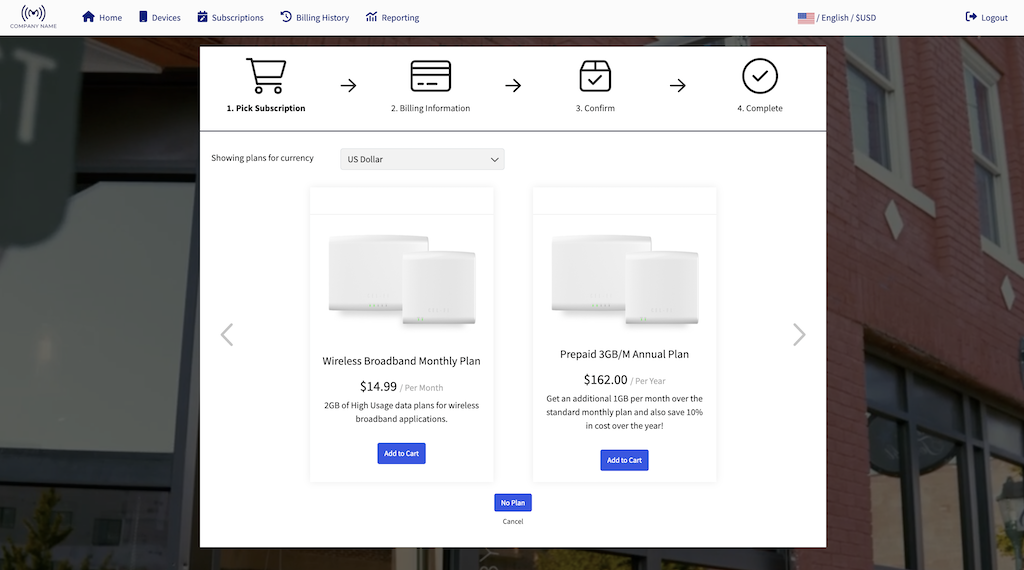
Custom-branded payment portal
Multi-carrier management
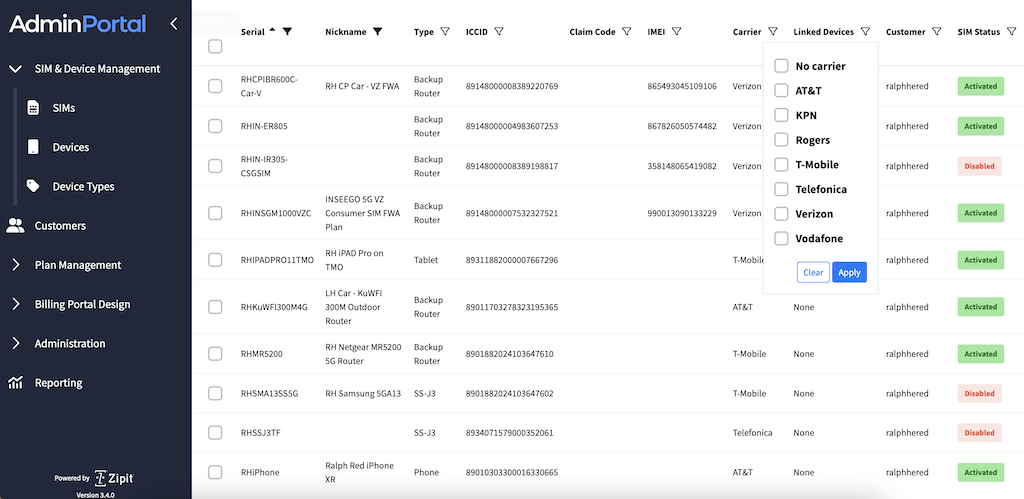
Easy SIM activations
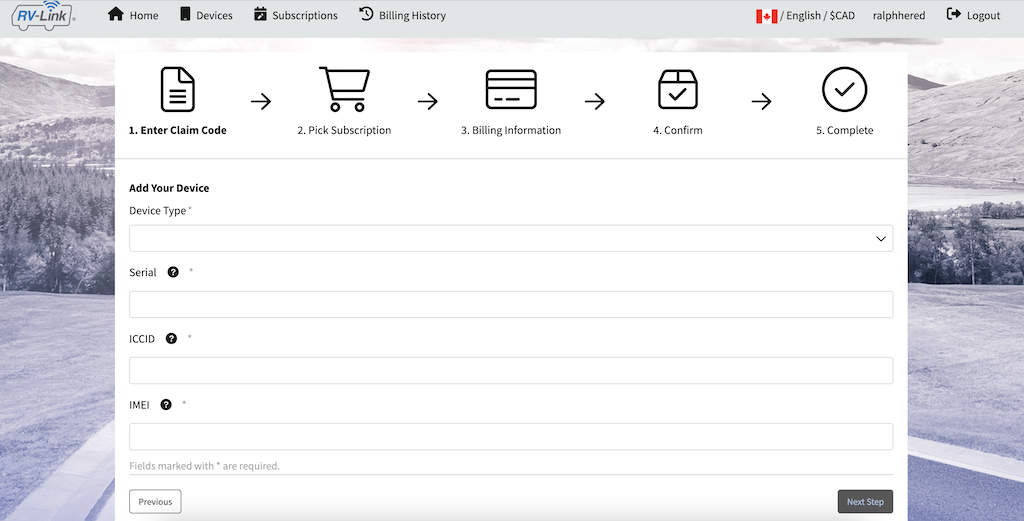
Dual SIM management
Dashboard and reports on active devices, usage, cellular service, revenue, refunds, and churn rate
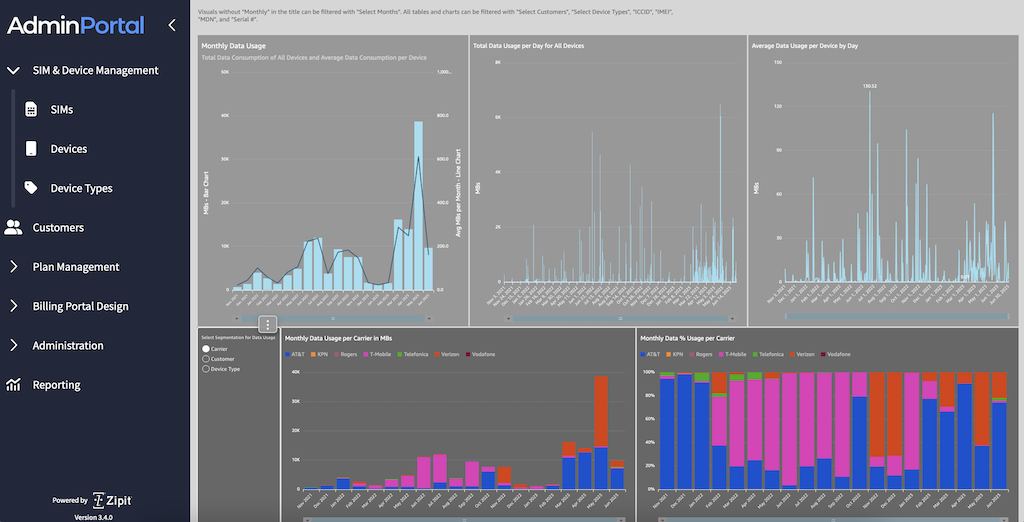
Usage notifications
%20-%20Data%20Usage%20Notification%20Preview.png?width=1024&height=871&name=Admin%20Portal%20(RVLink)%20-%20Data%20Usage%20Notification%20Preview.png)
Upsell opportunities
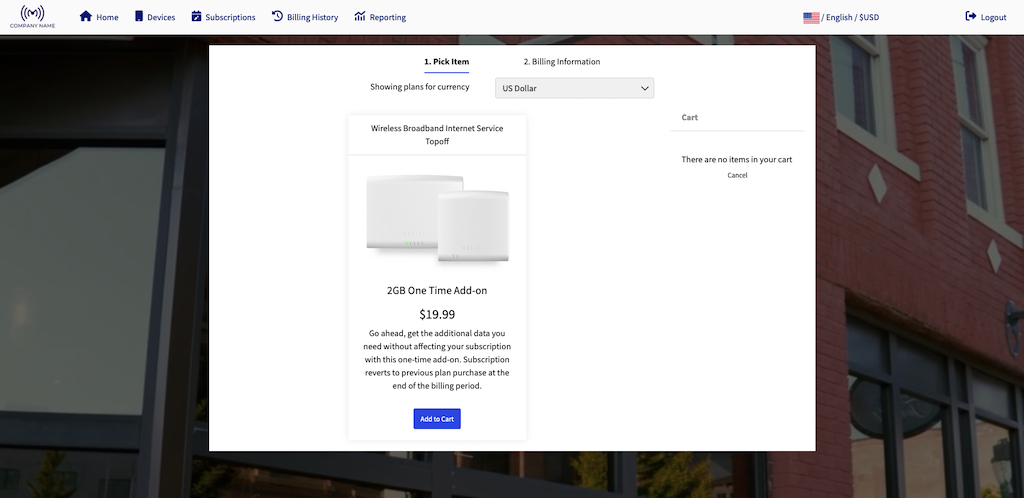
Simplified billing
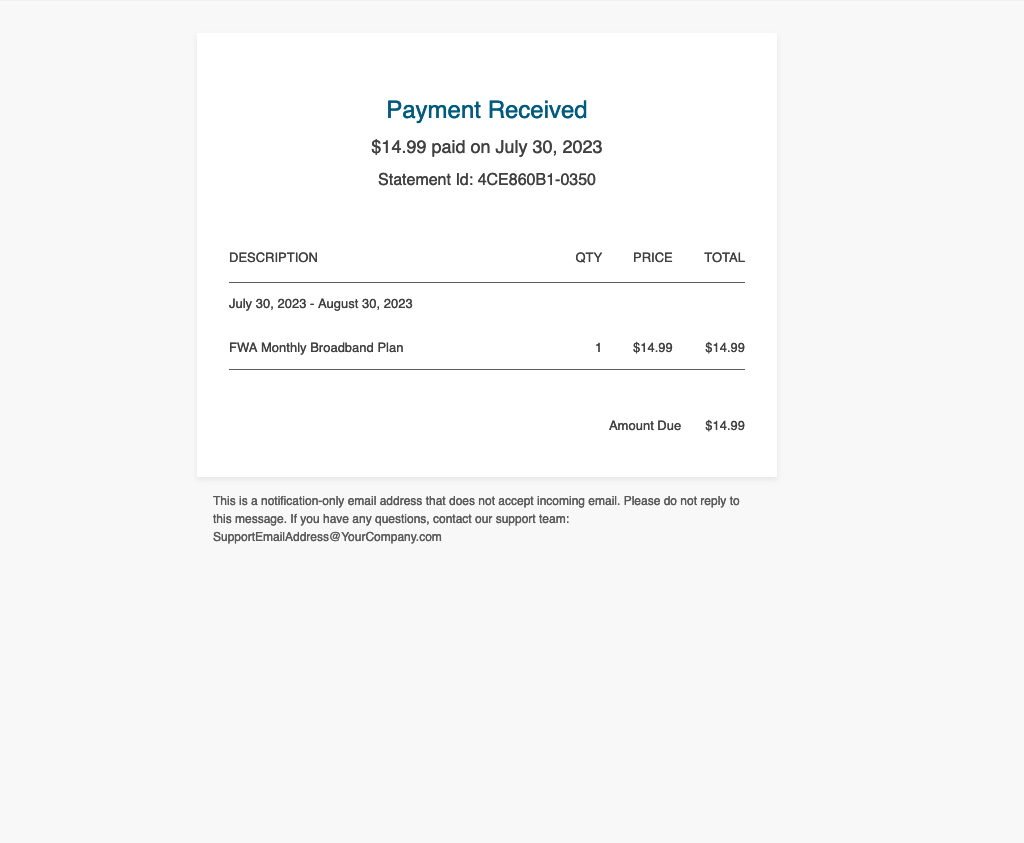
The Zipit Wireless customer portal
Zipit's branded customer portal offers convenient, on-demand device activations and flexible subscription plan selections or upgrades at any point in the billing cycle. With automated invoicing and secure transactions and refunds, the portal streamlines the billing process, ensuring a seamless experience for customers. Customers can access their complete billing history, view personal data reports, and receive notifications before they run out of data.
- Branded interface
- On-demand device activations
- Notifications when nearing the end of allotted data
- Automatic invoices
- Simple and secure transactions and refunds
- Billing history
- Personal data reports
How Zipit Wireless helps OEMs maximize revenue with subscription billing
At Zipit Wireless, our primary focus is to ensure the success of your IoT business. We offer a comprehensive platform with the necessary tools and data to manage subscription billing effectively. However, our commitment goes beyond just the platform. We are dedicated to guiding you in implementing subscription billing and scaling your solution.
Our Process: Discovery → Custom Solution → Platform Deployment → Guidance → Growth
Our process starts with in-depth discovery, where we engage in conversations with you to understand your specific needs, goals, and target markets. This enables us to create a tailored and customized solution that perfectly aligns with the unique requirements of your business. Once we have collaborated with you to develop a subscription billing strategy, we proceed with platform deployment and provide ongoing guidance throughout the implementation process.
We recognize that your business needs will evolve. As your strategic partner, we assist you in adapting your subscription model to accommodate these changes, ensuring that your subscription billing remains effective and aligned with your evolving business goals.
The growth projections for the subscription economy coupled with the increasing demand for connected devices create the perfect environment to monetize and scale your IoT solution. By embracing subscription billing, you can create recurring revenue by charging for ongoing connectivity and cloud access, data, and value-added services. Whether your IoT device is brand-new to the market or you are ready to scale your solution globally, Zipit can assist you at every stage with cellular connectivity, SIMs, subscription plans, and a device management platform that have helped many OEMs monetize their solution successfully.
Partner with Zipit for the tools, insights, and guidance to effectively manage subscription billing, drive growth, and earn long-term recurring revenue.
Zipit Blog
The latest IoT insights and platform updates from Zipit.
As billions of connected devices continue to shape modern life, IoT manufacturers ...
The Internet of Things (IoT) is transforming how businesses operate, compete, and ...
IoT asset tracking unlocks real-time awareness, predictive power, and operational ...

